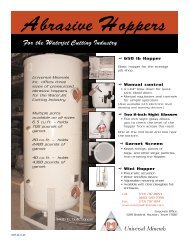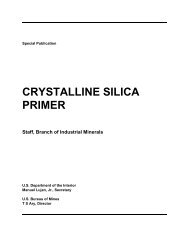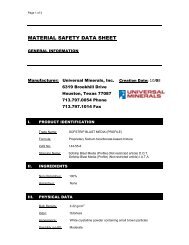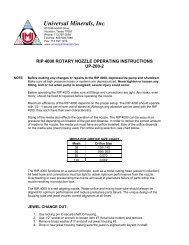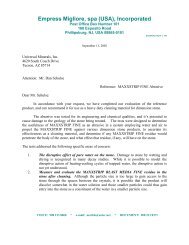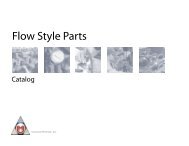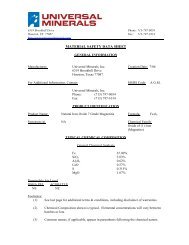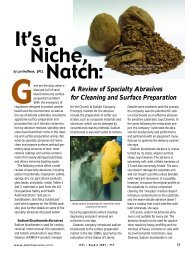Water Jetting, Buffing, Blasting - Universal Minerals, Inc.
Water Jetting, Buffing, Blasting - Universal Minerals, Inc.
Water Jetting, Buffing, Blasting - Universal Minerals, Inc.
Create successful ePaper yourself
Turn your PDF publications into a flip-book with our unique Google optimized e-Paper software.
TCEQ REGULATORY GUIDANCESmall Business and Environmental Assistance DivisionRG-413 • October 2007Complying with Rules on Surface Preparation:<strong>Buffing</strong>, <strong>Blasting</strong>, <strong>Water</strong> <strong>Jetting</strong>, etc.IntroductionThis guide gives the basics on rules that apply tosurface-preparation facilities. These facilitiesconduct activities such as buffing, dry abrasiveblasting, and water jetting, which prepare the surfaceof metal, wood, plastic, porcelain, and othermaterials for coating with primer, paint, and rustpreventionagents.In this guide you will read about air permits andauthorizations, paint and paint-related waste, andstorm water. Information about pollution prevention,best management practices, and obtaining technicalassistance from the Texas Commission onEnvironmental Quality is also included. Thisinformation does not take the place of any laws orregulations.Rules on Air EmissionsSurface-preparation processes emit inhalableparticulate matter. These fine particles are one of thesix criteria pollutants affecting air quality and publichealth that are monitored by the TCEQ and the U.S.Environmental Protection Agency.TCEQ regional offices frequently receive nuisancecomplaints against facilities that use surfacepreparationprocesses. Because of the potentialimpact on human health and the environment, theTCEQ requires facilities with activities or operationsthat emit pollutants, such as PM and volatile organiccompounds, to comply with the de minimis rule orbe covered under a permit by rule (formerly“standard exemption”) or a new source reviewpermit (air quality permit).Depending on the type of operation, the facilitymay also have to comply with requirements in 30TAC Chapter 111 for water-storage tanks andChapter 115 for control of VOCs.De Minimis RuleThe de minimis rule establishes a level of aircontaminants below which a TCEQ air permit is notrequired. If the operation or activity meets theABBREVIATIONSBMPs best management practicesCO carbon monoxideEPA U.S. Environmental Protection AgencyESL effects screening levelMSGP multi-sector general permitNOx nitrogen oxidesNSR new source reviewPBR permit by rulePM particulate matterPPRW paint and paint-related wasteSIC standard industrial classificationSO2 sulfur dioxideTAC Texas Administrative Codetpy tons per yearTCEQ Texas Commission on EnvironmentalQualityUW universal wasteVOCs volatile organic compoundsrequirements of the de minimis rule and can provideproof that it qualifies, then no other TCEQ airregistration or authorization for the facility isrequired.What types of facilities qualify for de minimisstatus?A facility can qualify for de minimis status in fourways:• If the type of operation is on the TCEQ’s list ofapproved de minimis facilities, then it qualifies.The list includes modular self-contained blastingcabinets that clean parts. View the list at. Copies may be requested by calling theAir Permits Division (see “Get More Information”at the end of this publication).• If certain amounts and types of materials areused at or below specific thresholds, the facilitymay qualify under the de minimis rule—forexample, less than 50 gallons of solvents and lessthan 100 gallons of coatings used per year.TEXAS COMMISSION ON ENVIRONMENTAL QUALITY • PO BOX 13087 • AUSTIN, TX 78711-3087The TCEQ is an equal opportunity/affirmative action employer. The agency does not allow discrimination on the basis of race, color, religion, national origin, sex, disability, age, sexual orientation, or veteran status. In compliance with theAmericans with Disabilities Act, this document may be requested in alternate formats by contacting the TCEQ at 512/239-0028, fax 239-4488, or 1-800-RELAY-TX (TDD), or by writing PO Box 13087, Austin TX 78711-3087. We authorize you touse or reproduce any original material contained in this publication – that is, any material we did not obtain from other sources. Please acknowledge the TCEQ as your source. Printed on recycled paper.
New Source Review PermitsIf the surface preparation activities do not meet deminimis or PBR requirements, a new source reviewpermit may be required. Obtaining an NSR permitrequires a detailed application, Best AvailableControl Technology (BACT), air dispersionmodeling, a toxicology review, public notice of thepermit request, and an extensive review—taking upto a year to complete.Facilities seeking authorization under an NSRpermit will need to complete Form TCEQ-10252, AirPreconstruction Permit and Amendments (PI-1).Most surface-preparation facilities do not need toapply for this permit unless they are using more thanone ton per day of dry abrasive material and workingon large movable objects, such as surface cleaningactivities at shipbuilding and ship-repair yards.View the surface preparation BACT requirementsat .Where can I find guidance about NSR permits?View NSR permit information at.Notification for Abrasive <strong>Blasting</strong> of<strong>Water</strong>-Storage TanksIf the surface-preparation activities compriseportable operations on immovable water-storagetanks, notifying the TCEQ may be required, but onlyif the lead concentration of the coating beingremoved is 1 percent or greater as described in 30TAC 111.131–39.If notification is required, it must include:• the location of the tank,• the name of the abrasive-blasting company,• the percentage by weight of lead in the coating,• control methods to be used, and• the expected hours of operation and a scheduleof start and finish dates.Submit the notification in writing to the localTCEQ regional office. Notification is due at least 10days, but no more than 30 working days, beforeabrasive blasting begins.Specific control requirements must be met if theabrasive activity is conducted in a residential orpublic area. View the water storage tank rules at. (Choose the firstbulleted link, then click on “111.”)<strong>Universal</strong> Waste Rule forPaint and Paint-RelatedWaste<strong>Universal</strong> waste is a specific type of hazardouswaste that is subject to relatively relaxed regulatoryrequirements regarding accumulation, recordkeeping, and shipping. UW does not count toward afacility’s status as a hazardous-waste generator, andis not subject to end-of-year fees imposed onhazardous-waste generation.Where Is the UW Rule?The UW rule can be found in 30 TAC 335.261–62.The Texas rule applies to hazardous used andunused paint and hazardous paint-related waste asdefined in 30 TAC 335.1(63) and 335.504. Paintrelatedwaste also includes any material that resultsfrom painting activities.For example, spent dry abrasive blasting material(such as silica sand and coal slag) would be PPRW ifthe material is produced as a result of paintingactivities, including removing paint or preparing anobject for painting.For more information on PPRW and the <strong>Universal</strong>Waste Rule, refer to Managing Paint and Paint-Related Waste under the <strong>Universal</strong> Waste Rule, TCEQpublication RG-370.What Are the Advantages of the UWRule?• No manifest is required when transportingPPRW;• notification to the TCEQ is not required if youare a small-quantity handler;• a registered transporter is not required;• the waste does not count toward the totalhazardous-waste-generator status;• the waste is exempt from year-end fees; and• the waste may be accumulated for up to a year.Industrial Multi-SectorGeneral Permit for Storm<strong>Water</strong>If the primary standard industrial classificationcode or activity code for the facility is included inthe multi-sector general permit, the facility will needto get proper authorization to discharge storm waterinto bodies of water in Texas or into a municipalseparate storm sewer system.TCEQ publication RG-413 • October 2007Complying with Rules on Surface Preparation • 3
The following surface preparation SIC codes anddescriptions are included in the MSGP and requirefacilities to submit a “no exposure exclusioncertification” or to develop and implement a stormwater pollution prevention plan and submit a noticeof intent:• SIC Code 3291—manufacturing of abrasivecleaning products.• SIC Code 3441—fabricating of structural metal.• SIC Code 3471—sandblasting of metal parts.• SIC Code 3479—coating of metals.• SIC Code 3731/3732—ship and boat building andrepair yards.• SIC Code 4493—boatyard storage and incidentalrepair yards.Get more information about applying for theMSGP (General Permit TXR050000) at or by contactingthe TCEQ’s Small Business and Local GovernmentAssistance Section (see “Find Out More”).Pollution PreventionTechniquesTry these techniques that help reduce andeliminate waste and emissions during surfacepreparation:• Remove spent blasting material from the site assoon as possible, or store such material incontainers or on top of ground that has beencovered with impermeable tarpaulins. Thencover spent material with another layer ofimpermeable tarpaulins to help reduce theamount of contaminated storm water runoff thatcould leave the site, and to help prevent windfrom blowing the blast media off-site.• When wet blasting or water jetting, recycle orproperly dispose of spent water.• Use a mesh or fabric shroud having a filteringfactor of 95 percent or better to prevent PM fromleaving the property.Best Management PracticesHere are some best management practices—suggested methods, tools, and techniques that can beused to control pollution from surface-preparationactivities:• Blast only when the wind direction and speedwill minimize adverse effects on humans,animals, and plants.• Take all reasonable precautions to preventparticulate matter from becoming airborne.• Store, handle, and manage abrasives and spentmaterial in a manner that prevents or minimizesTCEQ publication RG-413 • October 20074 • Complying with Rules on Surface Preparationtheir blowing off-site or otherwise creating anuisance.• Handle and move spent material in ways thatprevent extraneous dust and loss of materialuntil it is disposed of properly.• Maintain and keep all emission-controlequipment in proper working condition.• When using dry-abrasive blasting materials,make every effort to prevent the materials fromreaching any nearby waterway. Contain andcollect all visible floating solids that reach thewater.Find Out MoreContact the TCEQ for further assistance:• Air Permits Division, 512-239-1250• Wastewater Section, 512-239-4671• Small Business and Local GovernmentAssistance Section. Call (toll-free) 800-447-2827for confidential help with questions on air,water, waste, or pollution prevention issues.• Compliance-assistance specialists:Go to and click on “Find thenearest Compliance Assistance Specialist” for aregional specialist who can give confidentialhelp to small businesses and local governments.• Surface coating. For surface-preparation facilitiesthat are also involved in surface coating, view.• TCEQ publications and forms. Call 512-239-0028to request copies. You can also view or printpublications by going to andforms by going to.• Rules. For rules in PDF, visit.



